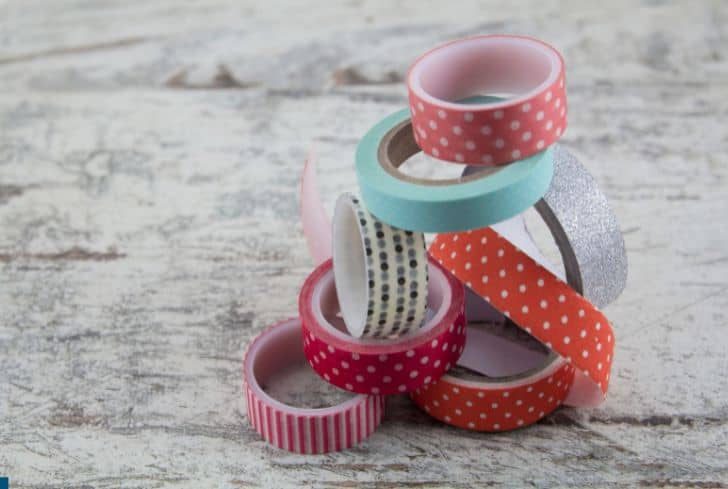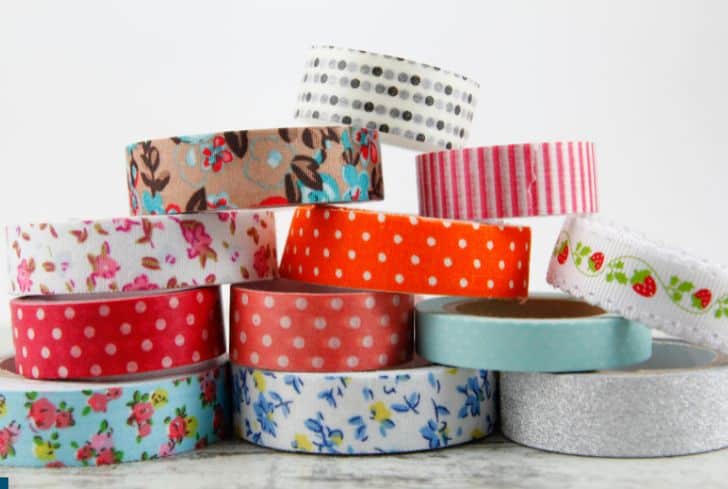If you aren’t artsy, the term “Washi tape” might have you wondering why there’s tape used for laundry or cleaning. Well, there isn’t. Washi tape is a Japanese-type high-quality masking tape used for art or decoration and is made of natural fibers such as bamboo and rice paper.
This tape is popular because it’s easy to use, inexpensive, and often comes in different colors and designs. The tape is also low tack, making it easy to reposition and reuse without causing damage, and you can even draw or write on it.
But in our daily quest for more sustainable ways of living, we have to examine if this new addition to the world of crafts and decoration is good for the environment.
If you want to jump on the trend and begin to incorporate this tape into your decoration but you’re not sure of its sustainability, you’re in the right place. In this article, we’ll be discussing if washi tape is recyclable and good for the environment.
Is Washi Tape Recyclable?
Yes, you can recycle your washi tape if your recycling center accepts tape. Recycling washi tape is easy because the material used to produce it is gotten from plants and shrubs. Most washi tape is paper with a sticky adhesive, and in the recycling process, the sticky adhesive is removed, leaving the paper to enter the process.
The tape is made into pulp and put in water and chemicals during the recycling process. All other elements in the tape that aren’t paper-like plastic tapes or glue detach and float to the surface where they are removed.
What is Washi Tape Made of?
Unlike traditional tape that is made from plastics or trees that aren’t sustainable, washi tape is made from Japanese shrubs and plants such as mulberry, gampi, mitsumata, or Hemp. Rice paper is the most common fiber used to make the tape, which is gotten from the bark of the mulberry plant.
The adhesive attached to the tape is made from natural rubber harvested from rubber trees. The material is harvested by tapping the trees and collecting the liquid. The liquid is then mixed with some chemicals such as solvents and plasticizers. These chemicals allow the adhesive to be sturdy and not peel off easily.
The process begins with the bark of the mulberry processed into pulp and shaken out to form a sheet. Then different types of rubbers, both synthetic and natural, are used to make the tape strong.
They are kneaded to easily dissolve in the solvent and blend into a softer material. The rubber comes in thick and hard blocks which are sliced thinly into 5mm slices.
Plastic resin is then added to the rubber while heat is applied, and once the mix is good and ready, it is used as the backing for the tape. The rice paper is set on top of a dyeing machine that applies glue on the back of the paper sheets. While this process is going on, a release agent coats the front of the sheet.
A thick protective coat is applied to the sheet so the tape doesn’t smear. Next, the rolls are reeled quickly and placed to be delivered to the main factory, where the finishing touches, such as cutting into smaller rolls, will be done.
Is Washi Tape Bad for the Environment?
No. Washi tape is made from natural materials like rice paper which is sustainable and safe for the environment. And the paper backing and adhesive are biodegradable and are allowed to break down naturally. The tape is also compostable so that it can provide nutrients for plants. You can also recycle it into other products.
The tape is also not toxic to humans, and the production process does not release harmful chemicals or toxins. However, to improve its eco-friendliness, the manufacturers can use more renewable energy sources in their production.
Also, unlike Western tapes with stronger adhesives made from trees that would have grown for over 20 years, Washi is made from shrubs and branches. This means that trees aren’t cut down in the process, and it doesn’t require so much growing time. The adhesive is also made from rubber which is sustainably tapped from rubber trees.
Is Washi Tape Compostable?
Suppose you’re trying to divert your washi tape waste from landfills to help the planet be cleaner. In that case, you might be considering composting your used washi tape to generate fertilizer and wondering if it’ll decompose.
Yes. Washi tape is compostable and can be added to your compost pile as a carbon-rich element. Although washi tape is made from natural materials, some can contain synthetic contaminants like foil or glitter, which would be left behind in your compost pile after the paper part has broken down.
So, to be on the safe side, it is advisable to cut your washi tape into smaller pieces and remove the synthetic part before adding it to your compost pile.
This allows the tape to spread equally around the pile and allows the bacteria to have a wide surface area to work with, which in turn causes the tape to break down faster. However, if you expect to get a considerable amount of fertilizer after composting your tape, you might be disappointed as it only produces a small amount.
Your compost pile containing your washi tape should have good airflow and high moisture levels to allow it to break down within months. If these conditions are not met, it will take a much longer time.

Does Washi Tape Damage Walls?
For those that want to use washi tape to decorate and beautify their homes, a significant concern would be if it causes damage to the walls.
Washi tape does not cause any severe damage to walls. It doesn’t chip the walls but might leave lines from the adhesive residue after a few weeks or months. It can also create lines under the tape for places where sunlight hits directly.
Washi tape is designed for temporary decoration and is made from low-tack adhesives, making it easy to remove from walls without leaving any residue, unlike other types of tape. This property also allows it to fall off on its own and be reused.
The tape also doesn’t break your paint or damage your pictures because it’s made from natural materials like Hemp or rice paper, making them less aggressive and thinner than other tapes. But it’s not advisable to stick it to recently painted walls in case some of the paint comes off.
However, if your tape has been stuck firmly on your wall for a long time and you’re worried it might have picked up something, simply pull up one corner of the tape with a piece of paper or your fingernail.
Once you’ve raised enough of the tape, simply pull it back slowly, being careful not to pick up anything as you’re pulling. Don’t attempt to pull out the tape quickly to avoid damaging the wall.
Some people try to make their washi tape stick better by adding a spray adhesive to the wall before attaching the tape. This method is more likely to cause damage to your walls because the spray is a stronger adhesive.
Does Washi Tape Damage Photos?
The simple answer is No. Washi tape is a gentle type of tape and comes off any surface easily. When attached to photos, you can be sure that it will come off easily and won’t cause any damage to it. The tape is optimized for crafts and decorations, which is why it’s widely used for scrapbooking.
Does Washi Tape Stick to Fabric?
Yes, washi tape can stick to fabric, but it might not stick for a long time. If the material is moved about or worn, the washi tape will most likely come off. It can also come off after it’s been on the fabric for a long time or if it’s put in water.
Washi tape is a temporary type of tape that selects what it sticks to. The tape is better suited for harder surfaces such as wood, glass, or plastic. It also doesn’t have a lot of strength, so it’s better to only put it on clothing that you don’t need to bend as it will curl at the end or remove altogether.
Can you Recycle Paper with Washi Tape on it?
Washi tape itself is recyclable because of the natural materials it’s made of. But when it’s attached to the paper, you might be confused while trying to recycle it. However, you can recycle paper with washi tape since it is also made of paper.
If you’re concerned about the glue on the washi tape, it will be separated and removed from the actual paper after chemicals have been added during the recycling process.
However, some recycling companies might refuse to take them in if the tapes and papers are too much. To avoid this, you can separate the washi tapes from the papers before taking them for recycling.
What to do With Old Washi Tapes?
When you’re no longer using your washi tapes, and you don’t want to throw them out or compost them just yet, there are a number of ways you can reuse your old tapes so you can get a bit extra value for your money.
Washi tape is designed for use on various surfaces, highly durable and reusable. So, here are a few ways to repurpose your old ones:
1. Paper clips
You can cut up used washi tapes into cute little shapes and designs and attach them to your paper clips. Simply slip the tape into one side of the paper clip with the sticky sides on the inside and the colored part on the outside. Divide it into two equal halves with the side of the clip in the middle, then stick them together.
2. Bookmarks
Old washi tapes can be used as makeshift bookmarks. So, when you’re reading a book, you’ll have a colorful reminder of what page you stopped.
3. Colorful Coasters
If you use plain single-colored coasters while serving tea, you can add a little spice to them by using your old washi tapes to decorate them. You can cut out the patterns from the tape and stick on the coasters or wrap them up completely with the tape.
4. Washi Tape Flowers
You can get crafty with your old washi tape by cutting them up to make beautiful bunches of flowers because what’s better than colorful artificial flowers? Flowers that will almost never die and don’t need care.
5. Cards
Using your old washi tapes to design birthday, Christmas, or get-well-soon cards is a great way to repurpose them. It’s also a great way to get them out of your home.
Conclusion
Washi tape is an excellent alternative to your conventional tape. It’s recyclable, reusable, compostable, and made from renewable materials. It is definitely a step in the right direction if you’re looking for more eco-friendly tape alternatives.






